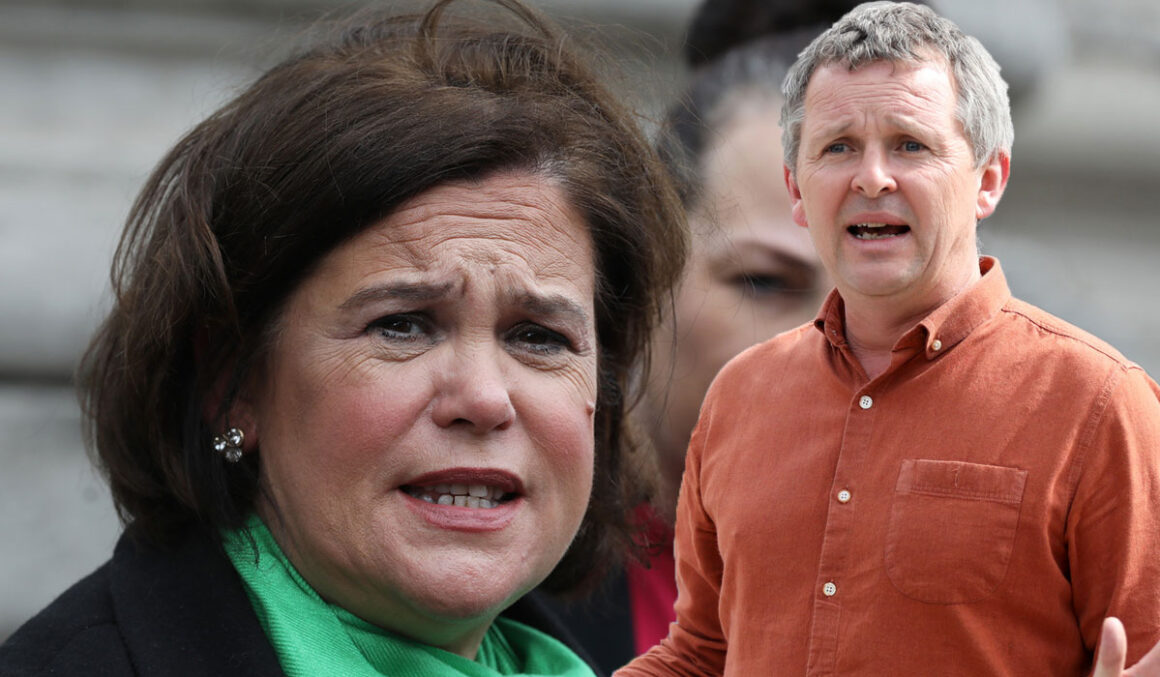By Eddie McCabe
The following article was first published in issue #18 of Socialist Alternative, the theoretical magazine of Socialist Party.
Sinn Féin became the largest party in the south for the first time in the general election of 2020, with 24.5% of the vote. In three opinion polls after the election but before the outbreak of the Covid pandemic it shot up to 35%. The instability of the pandemic allowed Fine Gael, the biggest government party, to regain ground and some stability in its support. But this began to dwindle in late 2020 with SF overtaking it again, and since July 2021 every poll has put Sinn Féin as the largest party, usually in the low- to mid-30s – with Fine Gael (FG) hovering around the low-20s, and Fianna Fáil (FF) around the high teens.
This is a significant change in the political landscape in the South, and coupled with Sinn Féin’s rise to become the largest party in the North, means that the dynamic around Sinn Fein and where it goes will be a defining feature of Irish politics in the next few years. Potential does now exist for a government without either FG or FF for the first time in the history of the state, which would be viewed as momentous. Naturally, this trend has generated ample commentary and analysis from all quarters, including in previous issues of this journal.1 In the last such article we detailed Sinn Féin’s further shift to the right, ingratiating itself with the business establishment in particular, and we critically analysed People Before Profit’s (PBP) view of Sinn Féin and the misguided tactical approach that flows from this, including the problem of sowing illusions in Sinn Féin.
Since then PBP has gone somewhat further in developing both its view of Sinn Féin and the potential for a ‘left government’ in Ireland, with the publication in February of its pamphlet: The Case For a Left Government – Getting Rid of Fianna Fáil and Fine Gael.2 In some respects this pamphlet indicates a more clear-sighted position on the question of a left government and the challenges it would face, but its overall analysis is not fully coherent, in large measure because of its contradictory but on the whole mistaken view of what Sinn Féin is and where it’s heading. This article will briefly explain where we think PBP gets it wrong, which will hopefully contribute to a better understanding of how the question of a Sinn Féin government should be approached by those on the left.
Hated and despised?
The PBP pamphlet tells us plainly that, “the privileged elite hate and despise Sinn Féin.” It asks us to:
“Imagine for a moment, the reaction in the Shelbourne Hotel bar or the Portmarnock Golf Club to the news that a left-wing party or Sinn Féin will form the next government. A mood of fear mixed with horror would overtake the gathering.”
This hatred and fear of Sinn Féin, we’re told, explains, “why there is a continual onslaught on the party from the mainstream media.” But is any of this a true reflection of how Sinn Féin is viewed by the capitalist establishment today?
Six or so years ago, when Gerry Adams was still leader of Sinn Féin, such an assessment would have had more legitimacy, but that’s no longer the case. With the ascension of Mary Lou McDonald and particularly with its rise to become a realistic prospect to lead a government in the short-term, which has coincided with a further shift to the right by Sinn Féin itself, there has been a notable softening towards Sinn Féin by the mainstream media. It isn’t vilified in the way it once was – as merely the political wing of a paramilitary organisation, even one that’s no longer active. McDonald and most current Sinn Féin TDs were never part of the IRA. As such, it just doesn’t work. Moreover, as the main opposition party Sinn Féin is well represented in mainstream political discourse – where its policies are treated with increasing credibility by establishment commentators.
Hence, we read in the Irish Independent, historically the newspaper most hostile to Sinn Féin, analysis such as this:
“On corporate tax, the tech titans have little to worry about. Sinn Féin now resembles Fine Gael and Fianna Fáil far more closely than Irish left-wing parties… On EU policy, Sinn Féin is unrecognisable from the party that regarded the EU as a neo-liberal, military plot and campaigned against every EU treaty up until relatively recently. There is no longer any fear that the party opposes EU-wide laws.”3
And in The Irish Times we read that:
“While Gerry Adams famously said in 1979… that the party was ‘opposed to big business, to multinationalism… to all forms and all manifestations of imperialism and capitalism’, it has more recently taken to courting enterprise – with its leader Mary Lou McDonald’s recently travelling to Silicon Valley, addresses to Ibec and senior party figures increasingly meeting business leaders.”
The same article tells us that:
“‘Sinn Féin in government won’t be anywhere near as radical as many might think…’ Sinn Féin has been moderating a number of policy positions in recent times, according to [Prof. David] Farrell of UCD, and is likely to compromise on others in any coalition discussions.”4
Articles like these are hardly uncommon. Arguably, they could be read as attempts by these media outlets to undermine Sinn Féin among those working-class and young people who would like to see Sinn Féin take a more radical stance; to move further left not further right. But Sinn Féin is in fact moving to the right, and this is the message Sinn Féin itself is trying to present. Thus, Pearse Doherty is quoted as insisting that: “Sinn Féin are pro-business,” and that, “nobody who wants to see a radical programme by Sinn Féin wants business to be punished.” He further states that Sinn Féin will “balance the books”, echoing the neoliberal tropes of his two main rivals.
Of course those rivals, FG and FF, are still the preferred options of the ‘privileged elite’, and certainly FG and FF politicians ‘hate and despise’ Sinn Féin; but this is less and less to do with Sinn Féin being seen as a threat to the interests of Ireland’s capitalist establishment, and more and more to do with Sinn Féin being seen as rivals to represent the interest of Ireland’s capitalist establishment – at the expense of FG and FF, and particularly their elected reps.
Coalition is not actually the main problem
Now, it’s not as if PBP doesn’t recognise this shift to the right by Sinn Féin; it does – it just seems unwilling to accept the full import of what this means for the prospect of a genuinely left government. And this refusal is a by-product of PBP’s more fundamental illusion that Sinn Féin is more radical than it really is, which is linked to its mistaken belief that nationalism is more progressive than it really is.
This is evident in the overemphasis PBP puts on the issue of Sinn Féin being open to coalition with FG and FF. Absolutely this is significant, and should be highlighted to expose the reality of SF’s desire to, in reality, be part of the capitalist establishment rather than upend it. As such it is correct to demand that Sinn Féin should rule out such coalition deals, and to criticise its refusal to do so. However, the impression one could take from PBP’s analysis is that the danger of such deals is that they will stifle or obstruct Sinn Féin from implementing the radical change that it would otherwise implement if only given the chance. For example, PBP says:
“These right-wing parties represent the interests of the rich and privileged and so would only join a Sinn Féin led coalition to ‘house train’ the party into the practices of the Irish political establishment.
Unfortunately, recent experience in the North illustrates this. Sinn Féin has been in coalition with the DUP from 2007 to 2020. During that time, they implemented austerity policies and supported measures to reduce corporation taxes on the wealthy… There can be little doubt that the presence of Fianna Fáil in a coalition with Sinn Féin would produce a similar conservative result.”
While this is partially true, it’s not actually the main issue. SF’s openness to cooperate and compromise with these right-wing parties says something about Sinn Féin itself: that fundamentally its political programme and approach are closer to those of these capitalist parties (FF especially) than they are to those of anti-capitalist and socialist parties. The DUP didn’t force Sinn Féin to implement austerity policies, it did that willingly.
Anyone expecting radical change from Sinn Féin will be seriously disappointed. Indeed Sinn Féin has been careful in recent times to moderate its stances, which is part of a strategy to ensure it says and does just enough to do well in elections, but also that expectations of what it will deliver are not too high. Its housing policy, for instance, is for 100,000 public homes to be provided over five years.5 This would be an improvement on what’s gone before, but it’s still considerably short of the 250,00 that even Leo Varadkar has conceded is needed6 – and even this is reliant on private contractors to build them, which is far from a surety.
Not a radical party
Again it’s not as if PBP doesn’t see any of this in Sinn Féin. Its pamphlet notes that,“Sinn Féin’s policy is to leave intact the main pillars of tax haven Ireland” (not exactly a minor difference with a left or socialist policy). Yet PBP’s consistent refrain is to be surprised7 and aghast8 at every about-turn Sinn Féin makes as it prepares for power9 – the latest being Sinn Féin’s announcement that it will not withdraw Irish defence forces from EU and NATO military arrangments such as Pesco and Partnership for Peace.10
The seeming inconsistency in PBP’s analysis is partially explained by its view of “a contradiction at the heart of Sinn Féin”, which it says flows from Sinn Féin’s attempt to “straddle different constituencies and different classes, avoiding taking clear stances that will alienate some of its support base.”
There is of course a contradiction in Sinn Féin’s attempt to win support from those looking for radical change (workers and young people) and those looking for temperate change (some corporations, bosses and wealthy people), which can’t both be satisfied by the same policies. But PBP overstates this contradiction, which in any case is not unique to Sinn Féin. While it tries to play a balancing act between the interests of working-class people and the system that exploits them, there’s little doubt on which side Sinn Féin will come down in the end. Still, PBP holds out some hope, writing:
“However, even while making these moves to the centre, the party sometimes tacks left. It plays an active role in the Cost of Living Coalition (COLC) and has helped mobilise thousands of people on the streets…
All of this means that while Sinn Féin can be a vehicle for working-class aspirations, the contradiction in its ranks means it will constantly try to moderate these. It will not promote people power from below and will urge waiting for governmental change. This, however, is a grave mistake for two reasons. The more working people remain passive, the more de-politicisation and right-wing cynicism grows. Moreover, if Sinn Féin is adopting a moderate left strategy now, the chances are that it will succumb to capitalist pressure when in government.”
This whole analysis is inaccurate, beginning with PBP giving credit to Sinn Féin for its role in ‘mobilising thousands on the streets.’ With its position as the main opposition party, the party with most TDs, probably the largest active membership, the most financial resources, and the party consistently leading in opinion polls for two years now, Sinn Féin would surely have enormous capacity to mobilise people into active struggle. What’s striking is what little inclination it has to use its resources and influence in this way. At most it has engaged in token mobilisations of its own members on certain issues like housing and cost of living, but little else – and it has been notably absent from efforts to actively resist the emerging far right. Historically, Sinn Féin has never based itself on mass struggles of working-class and young people; indeed whenever such struggles have developed from below, as with the water charges and repeal movements in the South, Sinn Féin has been extremely flatfooted.
In that sense, PBP has it all wrong: Sinn Féin cannot be ‘a vehicle for working-class aspirations’, precisely because these aspirations can only be achieved through struggle. But then PBP does also acknowledge this (undermining its previous point about COLC), noting correctly that Sinn Féin will tend to steer people towards elections, not active struggle. PBP insists that this is a ‘grave mistake’ and a boon to those forces who would rather see working-class people unengaged and atomised. What PBP fails to see, however, is that Sinn Féin is one of those forces, and far from a mistake this is a calculated strategic decision on its part.
Similarly, PBP fails to see that the problem is not that there’s a good chance Sinn Féin will ‘succumb to capitalist pressure when in government’, of which its ‘moderate left strategy’ is a forewarning; it’s that its moderate left strategy is evidence of its already having succumbed to capitalist pressure. This is vital to understand, and should inform how the question of a left government is posed and approached.
Not a left government
All of this leads to a peculiar disconnect between PBP’s outline of what a left government should or would do and its focus on the prospect of a Sinn Féin-led ‘left government’.
For example, some of what PBP describes as what a left government would mean is noteworthy: a raft of pro-worker policies, including taxes on wealth and profits, massive investment in public services, and some nationalisations; an inevitable confrontation with the capitalist state, financial institutions, and the EU; and the need to consistently mobilise ‘people power’ enmasse, including potentially forming ‘people’s assemblies’ – the embryo of a radically democratic alternative to the capitalist state. Much of this is laudable, and indeed a progression on PBP’s own position, which has rarely if ever been articulated in this way before.
So good in and of itself, but all of which also makes its focus on Sinn Féin all the more incongruous. Not only has Sinn Féin given no indication that it favours such a radical programme, it has explicitly and repeatedly explained that it is opposed to anything resembling such a radical programme. Yet PBP continues to speak of and argue for a left government led by Sinn Féin as if this wasn’t the case.
Again this relates to PBP’s inconsistency, which manifests in it more often presenting a potential left government as something far less radical than the above. The impression is often given, including in parts of this same pamphlet, that a left government would be any government that doesn’t include FG and FF – and implements some reforms. No doubt Sinn Féin offers the most likely route to a government of this kind, but as well as Sinn Féin’s own moderate programme being dominant, that government would most likely also include some combination of the Labour Party, Social Democrats and the Green Party.11 In which case, while it would technically be a leftward shift from what FG and FF represent, it would not be a left government that would in any way challenge capitalism, or fundamentally improve the lives of workers and young people.
Referring to this prospect as the ‘left government’, which PBP has a tendency to do, is therefore hugely problematic.
Tactical manoeuvres
After outlining its perspective on Sinn Féin and the potential for a left government, PBP sums up its position as follows:
“However, while openly arguing that Sinn Féin cannot be trusted to carry through a consistent left programme, People Before Profit recognises that many working people currently see it as a vehicle for their aspirations. This is why we commit in advance of an election to vote for Mary Lou McDonald as Taoiseach if she is willing to lead a government that does not include Fianna Fáil or Fine Gael…”
This position is similar to the one we advocated in our last article. If votes are needed to allow an alternative government, without FG or FF, to come to power, socialist TDs could facilitate that without supporting that government – from the inside or outside. In this way a Sinn Féin-led government can be tested in practice while a genuine left alternative is built in opposition: both inside the Dáil – where socialist TDs will vote for policies that are in the interests of working-class people and against those that are not; and outside the Dáil – where struggle is organised in workplaces, communities, colleges and schools. Make no mistake, even if a Sinn Féin-led government implements some improvements in some areas in the short term, the logic of the capitalist system it’s determined to work within means that its reverting to attacks on working-class people is only a matter of time.
But PBP goes further, writing:
“We go further and state openly that we want to participate in a left government that transforms people’s lives for the better and represents real change from the old Fianna Fáil-Fine Gael status quo… We will participate fully in that project, but such a government must be willing to break the rules of capitalism and challenge the obstruction of the rich and encourage the struggles of workers against the for-profit system.
In the event of TDs being elected, we shall enter discussions with Sinn Féin to form a left government without the two right-wing parties. We know that many of their own base support this and Sinn Féin should come under pressure to keep their word.”
Here PBP is in danger of making the mistake we warned about in our last article: of making commitments – for tactical reasons – that it can’t fulfil, which can both undermine its position in advance of an election,12 and backfire on it after it. The problem again goes back to PBP conflating the discrete ideas of a Sinn Féin-led government without FG and FF, which is a possibility, and a Sinn Féin-led government that challenges capitalism, which is not a possibility.13 Sowing illusions in Sinn Féin and what a Sinn Féin-led government can achieve is to mislead the working class, which is obviously not in the interests of the working class, and certainly not in the interests of socialists. It’s a recipe for demoralisation, which will benefit not only the right-wing establishment, but the nefarious forces of the far right.
An effective approach
After the next election PBP wants to negotiate with Sinn Féin about forming a ‘left government’, indeed it wants to discuss this with Sinn Féin in advance of an election. But what exactly it will be negotiating it doesn’t tell us, which is strange given that this pamphlet was billed as a development of its position. Yet PBP is even more cagey about the possible demands and ‘red lines’ it would insist on in order to participate in a government with Sinn Féin – things it has alluded to in the past, and things people will want to know.
No matter what PBP comes up with, however, Sinn Féin could make some concessions that can make PBP look unreasonable as a result, and responsible for any failure to agree a programme for government, and the dashing of hopes PBP itself has raised; by promoting the prospect of a left government that doesn’t really exist. Is PBP prepared to resist the pressure it would come under from all sides – from Sinn Féin and other parties, from the media, and even from its own supporters and voters? Or is it prepared to compromise? Of course it shouldn’t, as nothing good for the left can come from participation in what would be a capitalist government. But if it isn’t then why bother engaging in this charade at all?
There is unquestionably a real desire among working-class and young people to get rid of FG and FF. This is positive, and socialists have to be able to positively engage with this – explaining how it can be achieved, as well as its limitations and what’s really needed. But a skillful engagement with those workers and young people looking towards Sinn Féin, with a view to shifting them further left, beyond Sinn Féin, can be carried out effectively without the elaborate, ultimately misleading and counterproductive, tactical ploys PBP seems wedded to.
Notes
- Kevin McLoughlin, ‘Sinn Féin preparing for power in the South: Can it deliver real change?’, Socialist Alternative issue #14, Spring 2022, & Kevin McLoughlin, ‘Socialists & a Sinn Féin Government’, Socialist Alternative issue #16, Autumn / Winter 2022-2023
- PBP, Feb 2023, The Case For a Left Government – Getting Rid of Fianna Fáil and Fine Gael. All quotes are from this pamphlet, unless otherwise indicated
- Adrian Weckler, 11 Sept 22, ‘Mary Lou hitches up Sinn Féin party-mobile for Silicon Valley drive-by’, www.independent.ie
- Joe Brennan, 14 April 23, ‘Sinn Féin’s high-wire act: courting big business and those ‘left behind’, www.irishtimes.com
- Mairead Maguire, 8 Sept 22, ‘Sinn Fein promises 100k homes if elected’, www.newstalk.com
- P. Hosford & E. Loughlin, 8 Mar 23, ‘Leo Varadkar: Ireland has a shortfall of 250,000 homes’, www.irishexaminer.com
- PBP statement, 16 May 23, ‘Defend neutrality – but where does Sinn Fein stand?’, www.pbp.ie
- PBP statement, 28 Feb 23, ‘NATO & Ukraine: Where does Sinn Fein stand?’, www.pbp.ie
- Other recent examples include Sinn Féin attending the coronation of King Charles, or its effusive welcome of President Joe Biden to Ireland.
- Pat Leahy, 13 May 23, ‘Sinn Féin drops pledges to withdraw from EU and Nato defence arrangements’, www.irishtimes.com
- PBP wrote to Sinn Féin, Social Democrats and ‘left independents’ in March about discussing the formation of a left government after the next election. It has elsewhere ruled out including Labour and the Greens as part of such a coalition, even though their numbers are likely to be needed to form a government ‘without FG and FF’.
- If Sinn Féin is promoted by PBP as key to a ‘left government’, many people will just vote for Sinn Féin over PBP – as the larger of two supposedly left parties.
- Note also that PBP’s formulation, “break the rules of capitalism and challenge the obstruction of the rich”, is sufficiently vague that it can mean something far less radical than an actual challenge to the rule of the capitalist system, which is what a real left government would be. But in fact this is also in line with PBP’s own politics: its programme in all its key policy documents, its budget statements and even the books by its leading members is an explicitly reformist one – far more radical than Sinn Féin’s, but not one that breaks with the capitalist system.












